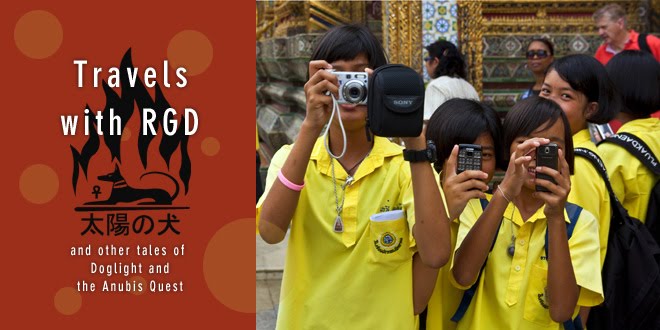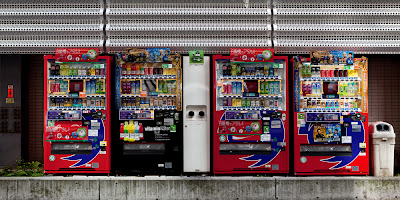(Tip: Click on photos to see a larger version or go to www.ronalddunlapphotography.com)
All marterials including photographs are ©2011 Ronald Dunlap / Doglight Studios.
All rights reserved.
The week before my flight, Tokyo had been hit by Typhoon Roke, and the long-range forecast had called for rain to continue during my visit; but luckily, the weather prognosticators were incorrect. On this bright morning, the crows outside my window were excitedly chatting back and forth across the gleaming manmade chasms of this part of town. Black harbingers of the work day, crows seem to have replaced the rooster. The roosters must have been either eaten or zoned out of the city, allowing the ubiquitous carrion crow to swoop into the time-honored position of herald of the sun, especially in the metropolitan Tokyo area.
Last night, I came to the conclusion that time was passing and I needed to start checking things off of my shot list. So today, I was heading one stop south on the JR Yamanote train line to Harajuku Station, to visit Meiji Shrine. I had read somewhere that on Sundays, there is a good chance to witness a portion of a Shinto wedding, and that was a big item on my list.
At Yoyogi Station, I used my Suica Card, for the first time, to get through the turnstile. I found the platform for the southbound train and waited, along with a lot of Tokyoites out for a little recreation on their day off. In a little over 10 minutes, I had arrived at Harajuku and made my way out of the station, which is only a hundred yards or so from the south entrance of the shrine.
Meiji Shrine was built at the turn of the last century to house the deified spirits of the Emperor Meiji and his wife Empress Shoken. He was enshrined for leading Japan out of its feudal era and into the modern age and westernization. Completed in 1921 and bombed into oblivion during WWII, it was reconstructed in 1958. The shrine is situated in the middle of 150 acres of evergreen forest, containing over one hundred thousand trees of various species, donated from every part of Japan.
This Shinto shrine is very popular with the Japanese people, especially during the New Year's celebrations. During the Hatsu-mode festival (on January 1), two to three million people make their way into the park to make their obligatory "first visit of the year." During this time, the shrine has its own train stop, and the priests actually use traffic signals to direct the massive crowds.
The majestic Tori, at the entrance, marks the beginning of the transition from the profane to the sacred. It's also the place where lots of tourist groups form to begin their visit. Once on the gravel path, it takes a while to get to the inner buildings, but it's a way of clearing the mind as you trudge along. The sound the gravel makes as it accommodates your weight is almost like a chorus chanting an absolution as you make your way to the holy of holies.
As you approach the offering hall and inner shrine, you need to stop at one of the holy-water fountains and purify yourself by rinsing off your hands and rinsing out your mouth. Nowadays, most people just wash their hands, choosing to forego the rinsing-of-the-mouth part of the ceremony.
Luck struck just as I was leaving the fountain. A wedding party came through the shrine gate, heading toward an area set aside for formal wedding photography. As discreetly as I could, I made my way over and began to shoot. The wedding photographers know their business: arranging the party so that everyone is in the correct position and as flawless as possible; making sure that ties are straight; and if anyone's coiffure needs a little smoothing, one of the team is there to make sure that there won't be any blemishes in the final image that commemorates the merging of two families.
I move back over to the forecourt, hoping to use the open doors of the gate as a pictorial window into the shrine. For the next 20 minutes, I stand there, hoping the crowds will thin out a little and allow me a couple of seconds to make the shot. Unfortunately, there are so many visitors I can't get a composition that I feel fits the bill. Walking away, I shoot some details of the structure and grab a no-looking shot of the inner shrine (they request that you don't photograph it, but so many Japanese were disregarding that plea that I felt licensed).
Turning around, I found another wedding procession making its way through the gate. It's like seeing the past come to life. They looked wonderful in their traditional costumes, and the proud fathers were just beaming, glowing almost as much as the bride. As the procession disappeared into the inner sanctum, I noticed the first wedding couple standing alone near one of the exits. I approached them and they graciously agreed to pose.
After I completed photographing them, I walked back to the inner courtyard, where a third couple had emerged from the sanctuary. The wedding procession moved across the inner court in a time-honored cadence on a traditional path that would serve as the foundation for their life together. I moved over to grab a few more shots. Again, the wedded couple was radiant in their traditional guise, beaming with happiness. I assumed they were relieved that the complicated ritual was nearing an end and that their life together was beginning. I was feeling very lucky to have witnessed this glimpse of Japan's past.
It was moving on towards mid-afternoon, and I too needed to move on. My next stop was Takeshita Street. It's Tokyo's most fashion-forward shopping area; supposedly very similar to Los Angeles' Melrose Avenue. It was easy to locate, being that it dead-ends into the train station's northern-most exit. A signage arch and wall-to-wall young people announce that you are there.
After cruising up and down the street, I was disappointed. There were lots of sundry shops, doing good business, but no in-your-face storefronts flaunting the work of young fashion designers. I was looking for something exciting, some new, unforeseen innovation that would further my faith in man's constructive rebellion; a flag in the sand, announcing their intentions to perpetuate progress by reshaping the norm into their irreverent vision. I spent an hour traipsing up and down, but nothing on this visit gave me pause. I gave up and took the train one more stop south to Shibuya.
Shibuya District is another of Tokyo's major entertainment and shopping areas, very popular with the affluent young. The premiere rendezvous spot in the area is the statue of the faithful dog Hachiko. Located in the forecourt of the train station, this bronze statue attests to the devotion of a white Akita dog for his dead master. Unfortunately, today the area around the statue is a designated smoking area, which means that often you have to view the statue through clouds of cigarette smoke, and to a dog-loving westerner, this seems to be an affront to the memory of this most loyal canine. I held my breath and took a few shots and then crossed the intersection that you see in all the photographs and movies that fronts this area. I crossed it with what seemed to be millions of others, looking for some side street that might hold something interesting to photograph.
At 7:30 I headed back out to Kabukicho, looking for targets of opportunity.









































































